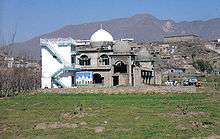Religion in Peru
| Part of a series on the |
| Culture of Peru |
|---|
 |
| History |
| Languages |
|
Traditions |
| Cuisine |
| Religion |
|
Music and performing arts |
| Sport |
|
Monuments |
|
Religion in Peru is characterised by a diversity of religious beliefs and practices.
Christianity
Roman Catholicism
The Peruvian government is closely allied with the Catholic Church. Article 50 of the Constitution recognizes the Catholic Church's role as "an important element in the historical, cultural, and moral development of the nation." [2] Catholic clergy and laypersons receive state remuneration in addition to the stipends paid to them by the Church. This applies to the country's 52 bishops, as well as to some priests whose ministries are located in towns and villages along the borders. In addition each diocese receives a monthly institutional subsidy from the Government. An agreement signed with the Vatican in 1980 grants the Catholic Church special status in Peru.[3] The Catholic Church receives preferential treatment in education, tax benefits, immigration of religious workers, and other areas, in accordance with the agreement. So Roman Catholicism could be considered the main religion of Peru. See also the following: Roman Catholicism in Peru; Catholic university with Partial list of Catholic universities in Peru; and Lord of Miracles, Peruvian religious festival.
Although the Constitution states that there is freedom of religion, the law mandates that all schools, public and private, impart religious education as part of the curriculum throughout the education process (primary and secondary).[4] Catholicism is the only religion taught in public schools. In addition, Catholic religious symbols are found in all government buildings and public places.
Protestants
As of 2013 there were approximately 10 to 11% of the population identifying themselves as Protestants, mainly Evangelicals (in Latin America most Protestants are called Evangelicos). They continue to grow faster than the national growth rate.
Other religions in Peru
The Church of Jesus Christ of Latter-day Saints
The Church of Jesus Christ of Latter-day Saints claims more than 8,000 members in Peru.[5][6] There are currently 764 congregations that meet in Peru.[6] This is down from 776 in 2012.[7]
There are currently two LDS temple in Peru, located at La Molina in Lima and a second temple in Trujillo. The LDS church also announced a third temple to be built in Arequipa, announced October 6, 2012.[8] In the most recent General Conference for the LDS church on April 3, 2016 it was announced that a fourth temple would be built in Peru in Los Olivos Lima. [9] This second temple in Lima makes the city one of the few in the world with two temples. Peru is also home to more than 100 stakes of the LDS church.
Buddhism
Buddhism was introduced to Peru in 1899 when the ship Sakura Maru arrived at Callao, Peru, with 790 people from Japan. Japanese, Chinese, and Korean immigration to Peru during the 19th and 20th Century brought Mahayana Buddhism to Peru, and followers of that style of Buddhism remain largely concentrated within those ethnic groups. While Mahayana remains the largest school of Buddhism in Peru, other schools such as the Diamond form have begun to spread so that Peru has more than 50,000 practicing Buddhists.
Bahá' Faith
The Bahá'í Faith in Peru begins with references to Peru in Bahá'í literature as early as 1916, with the first Bahá'ís visiting as early as 1919. A functioning community wasn't founded in Peru until the 1930s with the beginning of the arrival of coordinated pioneers from the United States[10] which progressed into finding national Peruvian converts and achieved an independent national community in 1961.[11] The Association of Religion Data Archives (relying mostly on the World Christian Encyclopedia) estimated some 41,000 Bahá'ís in 2005.[12]
Islam

The statistics for Islam in Peru estimate a total Muslim population of 5,000, largely based in the capital of Lima, Peru;[13] a number which has remained static since 1980.[14]
Seax-Wica
Introduced in 2001, by Seax Gesith Ariel Phoenice, Witan of the Mimir's Well Seax Coven Perú. Today two covens exist in Lima city as well a coven in Arequipa City and another in Tacna City Bob.
Notes
- ↑ "Las religiones en tiempos del Papa Francisco" (PDF) (in Spanish). Latinobarómetro. April 2014. p. 6. Archived from the original (pdf) on 4 April 2015. Retrieved 4 April 2015.
- ↑ International Religious Freedom Report 2007; Bureau of Democracy, Human Rights, and Labor; Published by U.S. State Department. Page 15
- ↑ Kevin Boyle and Juliet Sheen, Freedom of religion and belief: a world report. Routledge; 1997. Page 144.
- ↑ Michael Fleet and Brian H. SmithThe Catholic Church and democracy in Chile and Peru. University of Notre Dame Press; 1997. Page 201-202.
- ↑ "LDS Newsroom -Peru". Beta-newsroom.lds.org. 2011-12-24. Retrieved 2012-10-20.
- 1 2 "Peru". Church News. 2016-09-24. Retrieved 2016-09-20.
- ↑ "Peru". Church News. 2014-02-14. Retrieved 2016-09-20.
- ↑ "Trujillo Paru Temple". LDSChurchTemples.com. Retrieved 2012-10-20.
- ↑ {cite web url=http://www.ldschurchtemples.com/limalosolivos/}
- ↑ Lamb, Artemus (November 1995). The Beginnings of the Bahá'í Faith in Latin America:Some Remembrances, English Revised and Amplified Edition. 1405 Killarney Drive, West Linn OR, 97068, United States of America: M L VanOrman Enterprises.
- ↑ The Bahá'í Faith: 1844-1963: Information Statistical and Comparative, Including the Achievements of the Ten Year International Bahá'í Teaching & Consolidation Plan 1953-1963. Haifa, Israel: Hands of the Cause Residing in the Holy Land. 1963. pp. 19, 22, 23, 36, 46, 52, 109.
- ↑ "Most Baha'i Nations (2005)". QuickLists > Compare Nations > Religions >. The Association of Religion Data Archives. 2005. Retrieved 2009-07-04.
- ↑ Shaikh, Farzana. "Islam and Islamic groups: a worldwide reference guide", 1992
- ↑ "Islam in Latin America" (PDF). Retrieved 2012-10-20.
- ↑ http://worldwidewicca.wordpress.com/2011/11/22/informacion-de-la-religion-wicca-tradicion-sajona/
